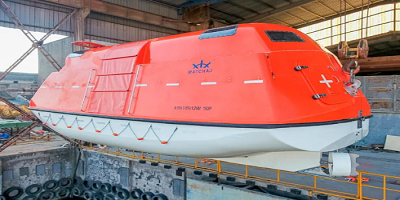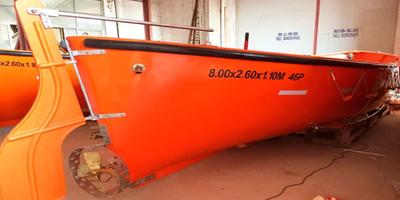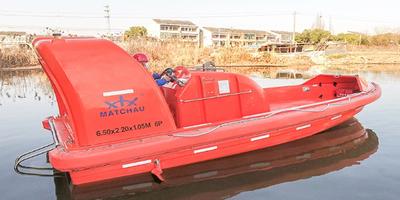In the realm of maritime safety, selecting the appropriate canopy light lifeboat is a decision of utmost importance. Whether for commercial ships, offshore oil platforms, or passenger vessels, the canopy light lifeboat plays a critical role in ensuring the safe evacuation of personnel during emergencies. A well-chosen lifeboat can make the difference between a safe rescue and a catastrophic failure. This guide outlines key factors to consider when choosing a canopy light lifeboat, helping shipowners, operators, and procurement professionals make informed decisions.

Before selecting a canopy light lifeboat, it's crucial to understand its intended application and the maritime regulations that apply. Lifeboats must comply with international safety standards, such as SOLAS (Safety of Life at Sea) and be approved by classification societies like DNV, ABS, or LR. A canopy light lifeboat is specifically designed with a protective canopy and integrated lighting system, which enhances visibility and protects occupants from harsh environmental elements like wind, rain, and UV radiation.
Ensure that the canopy light lifeboat you choose meets all relevant IMO standards and is certified for your vessel type—whether for cargo, tanker, or passenger service. It's also important to consider the total number of persons it needs to accommodate, which will determine the lifeboat’s size and seating configuration.

The construction material of the canopy light lifeboat significantly impacts its durability, weight, and long-term maintenance. Most modern lifeboats are made from glass-reinforced plastic (GRP), which offers excellent corrosion resistance and mechanical strength. The canopy should be made of fire-retardant materials and be UV-resistant to withstand prolonged exposure to sunlight and seawater.
Additionally, the canopy light lifeboat must be capable of withstanding rough sea conditions and impacts. Look for models that include reinforced hulls and are tested for high impact resistance. The quality of the integrated lighting system is also vital—it must function reliably in both low-visibility and nighttime conditions.

Another critical factor when choosing a canopy light lifeboat is the launch and recovery mechanism it supports. Lifeboats may be designed for free-fall or davit-launched systems. You must ensure that the canopy light lifeboat is compatible with the launching appliance on board your vessel.
Free-fall canopy light lifeboats are ideal for rapid evacuation in emergency scenarios and are often used on offshore platforms. Davit-launched models are more suitable for passenger ships where controlled, safe boarding is a priority. Regardless of the method, the lifeboat should be easy to launch and retrieve, even under challenging sea conditions. Automatic release hooks and self-righting features are also desirable.
When selecting a canopy light lifeboat, don't overlook the onboard features that contribute to safety and comfort. An ergonomic design with sufficient ventilation, anti-slip flooring, secure seating, and accessible storage compartments can greatly improve the survivability and well-being of occupants during rescue operations.
A reliable lighting system is essential for visibility, both inside and outside the lifeboat. The canopy light lifeboat should also include emergency supplies such as drinking water, flares, thermal protective aids, and first-aid kits. Some advanced models even come equipped with emergency communication systems and GPS locators.
Choosing a canopy light lifeboat is not just about the initial purchase—it's also about long-term reliability and support. Opt for a model that comes with clear documentation, training support, and a comprehensive maintenance schedule. Regular inspections, servicing, and testing are necessary to ensure the lifeboat remains in operational condition at all times.
Availability of spare parts, repair services, and technical assistance should also be considered when selecting a supplier. A reliable canopy light lifeboat manufacturer will offer long-term support and help you comply with periodic certification renewals.
| Selection Criteria | Key Considerations |
|---|---|
| Compliance Requirements | Must meet SOLAS and IMO standards; certified by DNV, ABS, LR, etc.; suitable for vessel type and capacity. |
| Construction and Durability | Made of GRP or similar durable materials; UV-resistant canopy; impact-resistant hull and reliable lighting system. |
| Launch & Recovery System | Compatible with onboard davit or free-fall systems; includes auto-release hooks and self-righting design. |
| Onboard Features | Ventilation, secure seating, anti-slip flooring, emergency kits, internal/external lighting, GPS (if available). |
| Maintenance & Support | Easy to inspect and service; availability of spare parts; good after-sales support and documentation. |
Selecting the right canopy light lifeboat involves careful evaluation of compliance standards, construction quality, onboard features, and maintenance requirements. The ideal lifeboat will not only ensure the safety of crew and passengers but also provide peace of mind for vessel operators. For those seeking dependable and SOLAS-compliant canopy light lifeboat solutions, Matchau is a trusted supplier known for its commitment to safety, innovation, and quality in marine life-saving equipment.